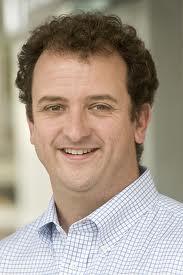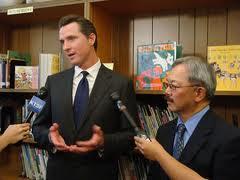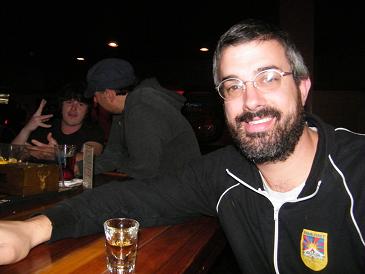› sarah@sfbg.com
The Mission District has been swarming with police officers lately. They were present and visible in large numbers in recent weeks in an effort to stem a recent tide of mostly drug- and gang-related killings in the heavily immigrant neighborhood.
"When 14, 15, and 13-year olds are running around with guns, we have a serious problem," San Francisco Police Chief Heather Fong said at a recent press conference as she urged the community to call 911, or the police department’s anonymous hotline, to report suspected shooters.
"All these people come from families, and these family members may hear or know something, or see a change in behavior," Fong said.
But community advocates warn that Fong’s boss has made it less likely that immigrants will talk to the police. Since Mayor Gavin Newsom’s recent decision to notify immigration authorities the moment the city books undocumented juveniles accused of committing felonies, fear that the Sanctuary City laws are eroding may be driving the very sources Fong needs deeper into the shadows.
Shannan Wilber, executive director of Legal Services for Children, told us that the new policy is already having an impact.
"It’s a warning sign that no one is safe, that people can’t go to Juvenile Hall and pick up their kids, because they’ll be swept up by ICE, too," Wilber told us. "People are saying, ‘We don’t feel safe reporting a crime we witnessed or were a victim of.’<0x2009>"
Mission Captain Stephen Tacchini told the Guardian last week that he’s not hearing that the community is clamping up because of the mayor’s newfound willingness to send juveniles to the feds for possible deportation. But he acknowledged that he doesn’t know the immigration status of folks who talk to the police at meetings and on the street.
"How many undocumented aliens come forward and assist us?" he asked. "Well, it’s possible they use the anonymous tip line."
PROTECTING PUBLIC SAFETY?
In an Aug. 8 San Francisco Chronicle op-ed, Newsom wrote, "the underlying purpose of the sanctuary-city policy is to protect public safety."
First signed into law in 1985, the city’s sanctuary ordinance designated San Francisco a safe haven for immigrants seeking asylum from war-torn El Salvador and Guatemala. The city extended the policy to all immigrants in 1989, saying it would not use resources or funds to assist federal immigration law enforcement, except when required by federal law.
Over the years, the city’s sanctuary legislation was amended to allow law enforcement to report felony arrests of suspected undocumented immigrants. City officials, however, came to believe that state juvenile law prevented them from referring undocumented juveniles to the federal authorities.
The city’s decision not to notify Immigration and Customs Enforcement about undocumented juvenile felons came under the media spotlight this summer when someone leaked to the Chronicle that the city had used tax dollars to fly undocumented Honduran crack dealers home. Some convicts were sent to group homes in San Bernardino County, and the city was left empty-handed and red-faced when a dozen ran away.
When the Chronicle articles hit, Newsom, who had just filed to explore a run for governor, claimed that the city could do nothing — the courts had jurisdiction over undocumented juvenile felons.
But the next day, Newsom did an abrupt about-turn.
"San Francisco will shift course and start turning over juvenile illegal immigrants," Newsom said. "We are moving in a different direction."
But the public was left in the dark about how far this new direction would veer until Sept. 10, when Siffermann unveiled details at a Juvenile Probation Commission meeting.
Community-based organizations and immigration rights attorneys complained that the policy ignored all but one of the recommendations they made in July and August to Siffermann, city administrator Ed Lee, and Kevin Ryan, a fired former US Attorney whom Newsom tapped to head the Mayor’s Office of Criminal Justice in January.
Angela Chan of the Asian Law Caucus warned the commission that the policy, which has already resulted in 50 juveniles being referred to ICE, may result in the deportation of young people who had not committed any crime, or whose felony charges were dropped.
Community organizer Bobbi Lopez asked commissioners, "Why do we have a political will to demonize these kids who have been trafficked into this country?"
And Francisco Ugarte, a lawyer with the San Francisco Immigrant Legal and Education Network, said the policy is akin to "rounding up all of Wall Street because there are bankers involved in insider trading."
The commission decided to form an ad hoc committee to review the policy, but the immigrant advocates and attorneys we contacted expressed little hope of change, given the impending presidential election and Newsom’s gubernatorial ambitions.
Some went so far as to suggest that the Joseph Russoniello, who opposed churches and synagogues offering sanctuary to Salvadorans and Guatemalans in the 1980s, and became the US Attorney based in San Francisco in January 2008, had drafted the mayor’s new policy.
Patti Lee of the Public Defender’s Office noted that the Mayor’s Office did not discuss the policy changes with her office, the courts, the prosecutors, or the people involved in immigration litigation.
Claiming that 99 percent of kids arrested in the city are not violent felons, Lee said, "They are mostly engaged in drug sales to survive and to send money back to their families."
Probation chief Siffermann defended the new policy direction. "Just because ICE is notified about suspected undocumented juvenile felons doesn’t mean they will be deported," Siffermann told us. "I know there’s a fear that this will open an automatic trap door to horrendous facilities and poor conditions, but this is not about dropping kids off in the middle of nowhere. What we are talking about includes outreach for families with adolescent members on the road to a delinquent involvement, whose actions call attention to the entire family situation."
Reached by phone, Russoniello told us, "If the city had scrupulously followed the ordinance as it’s written, there would not have been this controversy."
POLITICAL AGENDA?
Russoniello claimed that ICE’s first concern is people engaged in criminal activity, and agreed that in some cases, petitions may not be sustained against juveniles referred to ICE.
"But ICE may determine that the person is a member of a gang or engaged in regular criminal behavior," Russiniello added.
Russoniello also told us that the city is probably looking at its past files on undocumented juvenile felons to determine its own liability.
"Certainly, if people who are now adults were committing heinous crimes as juveniles, people are going to be wondering why they weren’t deported," Russoniello said, alluding to a June 22 triple homicide in which three members of the Bologna family were shot while returning home from a picnic.
Allegations emerged in July that the prime suspect in that killing, Edwin Ramos, 21, was an undocumented MS-13 gang member who committed felonies and went through the city’s juvenile system, but was never referred to ICE. That further embarrassed Newsom.
Kris Kobach, a one-time counsel to former US Attorney General John Ashcroft and the current Kansas Republican Party chair, is representing several surviving members of the Bologna family, who filed suit against the city claiming its sanctuary policies were a "substantial factor" in the slaying and blaming the Juvenile Probation Department for adopting "official and unofficial policies."
Russoniello claims that a review of monthly records that JPD has kept since 2004 show an uptick in alleged juvenile Honduran felons, and that this should have been a tip-off. "Are people gaming the system, or are organized groups taking advantage of the city’s leniency?" Russoniello asked.
Noting that 30 percent of these so-called teens were in fact adults and that significant numbers of gang members are "illegal aliens," Russoniello claims that the spur to shift policy was the city’s attempt to transport people back to Honduras in December 2007, which was brought to his attention in January, when he took office.
"We attempted to remedy it quietly, without much success," Russoniello recalls. "The city decided to send people to group homes. If you want to find a political agenda, look to the Mayor’s Office."
Calls to Ryan remained unanswered as of press time, but mayoral spokesperson Nathan Ballard e-mailed us that Newsom ordered a new policy direction May 22 "because he felt the old policy violated the intent of a sanctuary city, which is to promote cooperation by undocumented residents with law enforcement, not to harbor criminals."
The city attorney issued an opinion authorizing notification on July 1, Ballard wrote. Notification began July 3, and written protocols were publicly presented Sept. 10.
As for Russoniello’s comment about political agendas, Ballard retorted, "This isn’t about politics, it’s about public safety. In order to preserve the sanctuary city policy, we need to ensure that it complies with state and federal law so that it is not vulnerable to attack."





